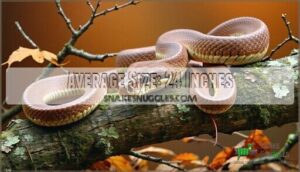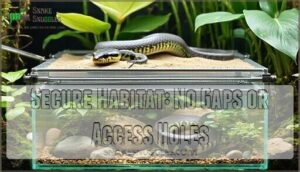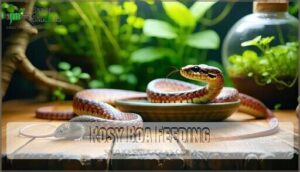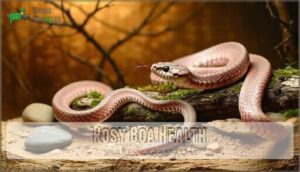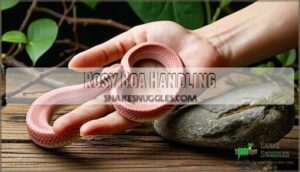This site is supported by our readers. We may earn a commission, at no cost to you, if you purchase through links.
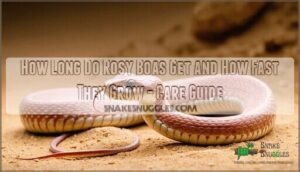 Your rosy boa will reach 24-36 inches in length, with coastal specimens potentially growing up to 48 inches.
Your rosy boa will reach 24-36 inches in length, with coastal specimens potentially growing up to 48 inches.
Starting as 10-inch hatchlings, they’ll grow 1-2 inches annually and achieve full size in 4-5 years.
This steady growth rate makes planning their long-term care straightforward – you won’t need to upgrade enclosures multiple times like with larger species.
Growth varies based on genetics, regional morphs, and feeding frequency, but expect your snake to double in size by year two.
With proper care, they’ll maintain this manageable size throughout their impressive 20-30 year lifespan.
Understanding their growth patterns helps you provide ideal nutrition and habitat conditions.
Table Of Contents
- Key Takeaways
- How Long Do Rosy Boas Get and How Long It Takes to Grow?
- Rosy Boa Size and Growth
- Rosy Boa Habitat
- Rosy Boa Feeding
- Rosy Boa Health
- Rosy Boa Handling
- Rosy Boa Care
- Frequently Asked Questions (FAQs)
- How long do rosy boas live?
- Are rosy Boas easy to care for?
- How fast do rosy boas grow?
- How big does a rosy boa get?
- How many babies does a rosy boa have?
- Where do rosy boas live?
- How long does a rosy boa live after birth?
- How much does a rosy boa cost?
- Are rosy Boas agile?
- What factors influence Rosy Boa growth rates?
- Conclusion
Key Takeaways
- Your rosy boa will reach 24-36 inches in length, with coastal specimens potentially growing up to 48 inches, making them a perfectly manageable size for long-term care
- Expect 4-5 years for full growth as they start at 10 inches and grow steadily at 1-2 inches per year, doubling their size by year two
- You won’t need multiple enclosure upgrades like with larger snake species since their predictable growth pattern makes planning straightforward from the start
- You’re committing to 20-30 years of companionship, so understanding their growth timeline helps you provide proper nutrition and habitat conditions throughout their impressive lifespan
How Long Do Rosy Boas Get and How Long It Takes to Grow?
Understanding rosy boa development reveals fascinating growth patterns and size variance.
Your rosy boa will typically reach 24-36 inches, with coastal specimens achieving 48 inches.
Expect your rosy boa to reach 24-36 inches, with some coastal giants hitting 48 inches
Boa development follows predictable maturation rates – hatchlings start at 10 inches, growing 1-2 inches annually.
This gradual boa growth rate means reaching full rosy boa size takes 4-5 years.
With proper care, expect impressive snake longevity of 20-30 years, making boa length a long-term commitment.
Factors affecting rosy boa size and lifespan are essential to understand for effective care, including diet and nutrition.
Rosy Boa Size and Growth
Understanding rosy boa size is essential when you’re planning their long-term care and habitat setup.
These desert natives typically reach 24-36 inches as adults, with some exceptional specimens growing up to 44 inches over their impressive 30-year lifespan.
The size of the rosy boa is crucial for determining the appropriate habitat setup.
Average Size: 24 Inches
Your rosy boa’s average size will reach approximately 24 inches as an adult, making them perfect for beginners.
However, size variance exists between individuals, with some coastal specimens reaching up to 48 inches.
Here’s what affects snake length:
- Growth patterns vary based on genetics and regional boa morphs
- Scale color variations don’t impact final rosy boa size
- Boa growth rate averages 1-2 inches yearly during development
Proper rosy boa care guarantees healthy growth within these parameters.
Lifespan: Up to 30 Years or More
When considering your pet’s future, rosy boa lifespan extends far beyond most small constrictors. These remarkable snake growth stages continue throughout their impressive lifespan in captivity of 20-30 years, with exceptional individuals reaching 40+ years.
Longevity Factors include consistent temperatures, proper nutrition, and stress-free environments. Quality veterinary care prevents common Health Issues like respiratory infections and mites. Survival Rates in captivity dramatically exceed wild populations due to controlled conditions and predator absence.
The Aging Process remains gradual, with reproductive capability lasting decades. Primary Mortality Causes stem from husbandry mistakes rather than natural aging. Your commitment spans multiple decades – plan accordingly for housing upgrades, veterinary expenses, and care consistency.
Wild specimens average 15-20 snake lifespan years, while captive boas consistently exceed this range, making them truly long-term companions requiring serious dedication. To guarantee the best care, understanding the proper snake habitat setup is vital for their well-being.
Rosy Boa Habitat
Creating the right habitat for your rosy boa directly impacts its growth potential and overall health.
You’ll need to provide adequate space, proper environmental conditions, and enrichment features that mimic their natural desert environment.
Enclosure Size: Minimum 24 X 18 X 18 Inches
Anyone can house their rosy boa comfortably in a properly sized enclosure.
A minimum 24 x 18 x 18 inches provides adequate space requirements for adult rosy boa size throughout snake growth stages.
Essential tank dimensions considerations:
- Floor space – More critical than habitat depth for terrestrial movement
- Ventilation needs – Proper airflow maintains ideal humidity levels
- Climbing structures – Rock stacks and caves enhance natural behaviors
- Growth accommodation – Tank size supports juveniles through adult stages
- Cleaning access – Enclosure size allows easy maintenance and substrate changes
This reptile size standard ensures your snake won’t feel cramped while remaining manageable for regular care.
Proper Rosy Boa Enclosures design is vital for the health and well-being of the snake.
Secure Habitat: No Gaps or Access Holes
Your rosy boa habitat security determines whether you’ll have a pet or a missing snake story. Proper tank sealing prevents costly escape attempts and protects your investment.
Habitat Security Essentials:
- Screen lid locks – Use metal clips or weighted tops to secure mesh covers, preventing your curious boa from becoming an unwelcome house guest.
- Seal all gaps – Check corners, ventilation areas, and door seams with a flashlight; if light passes through, so can your snake.
- Regular inspections – Weekly habitat checks catch wear before it becomes an escape route, saving you sleepless nights searching under furniture.
Proper enclosure design incorporates these safety measures without compromising airflow or accessibility for maintenance.
Climbing Opportunities: Rock Stacks, Caves, and Climbing Areas
Beyond secure housing, your rosy boa needs climbing structures that mirror their natural rocky terrain.
Rock stacks and cave designs create essential basking areas while encouraging natural exploration behaviors.
Climbing walls paired with strategic habitat decor accommodate your snake’s growth rate and adult snake size.
Proper climbing structures in your enclosure size optimize habitat setup.
When designing the enclosure, consider using materials from online rock shops(rock stack products) to create a natural environment.
| Feature | Benefit |
|---|---|
| Rock Stacks | Vertical exploration space |
| Cave Designs | Secure hiding spots |
| Climbing Walls | Exercise opportunities |
| Basking Areas | Temperature regulation |
| Multi-level Setup | Behavioral enrichment |
Humidity: 40-60%
Maintaining proper humidity levels between 40-60% supports healthy snake growth rate factors and overall rosy boa care.
Use water bowls and spray systems with adequate ventilation to control moisture levels.
Monitor these conditions closely since temperature and humidity work together.
Your snake’s shedding cycle depends on consistent humidity control, making this a key factor in your reptile growth success story.
Rosy Boa Feeding
Feeding your rosy boa properly is essential for healthy growth and development throughout their 20-30 year lifespan.
You’ll need to adjust feeding frequency based on age – juveniles require meals every 1-2 weeks while adults eat every 2-4 weeks, with prey items no larger than the snake’s widest body section, which is crucial for their development.
Frequency: Juveniles Every 1-2 Weeks, Adults Every 2-4 Weeks
After setting up your rosy boa’s habitat, establishing a proper feeding schedule becomes your next priority. Juveniles require meals every 1-2 weeks to support their rapid growth rate, while adults need feeding every 2-4 weeks due to slower metabolism.
This meal frequency directly impacts snake nutrition and overall development.
Here’s your feeding timeline:
- Hatchlings (under 1 year): Feed weekly for ideal snake growth rate
- Juveniles (1-2 years): Every 10-14 days supports steady reptile growth
- Sub-adults (2-3 years): Bi-weekly feeding maintains healthy development
- Adults (3+ years): Monthly feeding meets dietary needs without overfeeding
- Seniors (10+ years): Extended intervals prevent obesity-related health issues
Understanding growth factors helps you adjust your rosy boa care routine as your snake matures.
Feeder Size: No Bigger Than The Snake’s Width
Prey selection becomes vital when your rosy boa’s feeding techniques depend on proper sizing.
Snake nutrition experts recommend choosing feeders no wider than your snake’s thickest body section. This prevents digestion issues that can harm your pet’s health.
Using a snake size chart helps match prey size to your boa’s growth rate. Quality food choices support healthy development while improper snake feeding can cause serious problems.
Follow these snake care tips for ideal results, ensuring that you provide the best possible environment for your pet, with proper sizing being a key factor.
Rosy Boa Health
Proper feeding sets the foundation, but vigilant health monitoring guarantees your Rosy Boa thrives throughout its impressive lifespan.
Disease Prevention starts with maintaining humidity below 60% and stable temperatures to prevent respiratory infections. Regular Health Checks help you spot early warning signs like lethargy or abnormal breathing patterns.
Key health priorities include:
- Parasite Control through quarterly fecal examinations and clean substrate management
- Monthly enclosure sanitization to prevent bacterial buildup and fungal infections
- Veterinary Care from reptile-experienced professionals for annual wellness exams
- Snake Nutrition monitoring to prevent obesity and metabolic disorders.
Watch for respiratory symptoms like wheezing or mouth rot’s telltale sour odor. These issues often stem from poor hygiene or environmental stress.
Early detection dramatically improves treatment outcomes and supports healthy snake growth rates. To guarantee the best care, understanding rosy boa care is essential for maintaining a healthy environment.
Rosy Boa Handling
Rosy boas respond well to gentle handling sessions that let them explore at their own pace. You’ll find these docile snakes can develop a trusting bond with consistent, patient interaction.
Gentle Handling: Allows Exploration, Avoid Grabbing or Squeezing
When you’re around your rosy boa, gentle touch becomes the foundation of successful snake safety.
Allow your pet to explore freely across your hands and arms rather than restricting its movement.
Handling tips emphasize supporting the snake’s body weight while avoiding grabbing or squeezing prevention techniques that cause stress.
Exploration methods work best when you let your rosy boa dictate the pace.
Wait forty-eight hours after feeding before any handling session.
Proper rosy boa care includes recognizing stress signals like defensive posturing or musk release.
These handling tips guarantee your snake feels secure during interactions, supporting healthy snake growth throughout its impressive snake size range.
Bonding: Can Develop a Trusting Bond
Trusting Bond development happens through consistent, respectful owner interaction with your rosy boa. These beginner-friendly snakes respond well to gentle care and regular snake handling sessions.
Their docile temperament makes pet connection achievable with patience. Build rapport by moving slowly during snake bonding activities, avoiding sudden movements that stress your snake.
Quality rosy boa care includes respecting their comfort zones. Watch for relaxed body language—loose coils indicate trust.
Handling tips: start with brief sessions, gradually increasing duration as your snake becomes comfortable with your presence and touch. Effective snake handling involves understanding safe handling techniques to minimize stress and promote a trusting bond.
Rosy Boa Care
Creating the perfect environment for your rosy boa involves more than just the right enclosure size and temperature.
You’ll want to focus on substrate choice and environmental enrichment that mimics their natural desert habitat while supporting their burrowing instincts.
Rosy Boa Care Introduction
Creating the perfect environment for your rosy boa involves more than just the right enclosure size and temperature. You’ll want to focus on substrate choice and environmental enrichment that mimics their natural desert habitat while supporting their burrowing instincts.
Substrate: Terra Sahara
Terra Sahara transforms your rosy boa habitat into a natural desert sands environment. This burrowing medium combines organic potting soil, play sand, and decomposed granite, creating ideal soil quality for tunnel construction and humidity control.
Here’s why Terra Sahara works perfectly for rosy boa care:
- Natural burrow formation – Your snake can dig extensive tunnel systems mimicking wild behavior
- Moisture regulation – Retains enough humidity without creating soggy conditions that harm desert species
- Easy maintenance – Self-draining properties prevent mold while supporting your rosy boa habitat needs
This substrate directly impacts snake growth rate and overall health. Proper snake enclosure size paired with quality substrate creates an environment where your rosy boa thrives naturally. The quality of Terra Sahara substrate is vital for maintaining the right balance of moisture and humidity in the enclosure.
Clean Up Crew: Powder Orange Isopods and Arid Springtails
Introducing beneficial microorganisms transforms your rosy boa’s habitat into a self-sustaining ecosystem.
Powder Orange Isopods and Arid Springtails serve as nature’s janitors, breaking down waste and maintaining ecosystem balance.
These detritivores consume organic matter, preventing harmful bacteria buildup that could impact your snake’s growth rate toward adult size.
Microfauna management through proper isopod care and springtail diet creates ideal conditions for healthy development.
Provide Tunnels and Burrows
While cleanup crews handle waste management, your rosy boa’s psychological wellbeing depends on proper tunnel systems and hide boxes.
These snakes spend daylight hours underground, making burrowing materials critical for stress reduction.
Creating effective burrow designs requires understanding your boa’s natural instincts.
Wild rosy boas inhabit rodent tunnels and rock crevices, so your snake enclosure should mirror these conditions.
Provide 1-2 inches of substrate depth to support tunnel construction and prevent collapse.
Here are four key tunnel requirements that’ll transform your boa habitat:
- Multiple hide options on both warm and cool sides for thermoregulation
- Snug-fitting tunnels that make contact with the snake’s body
- Stable substrate like aspen shavings that won’t collapse during burrowing
- Secure placement of heavy décor before adding substrate to prevent injuries
Proper burrowing opportunities reduce nose-rubbing, escape attempts, and visible stress behaviors, creating a healthier environment for your rosy boa’s development.
Mimics Natural Environment by Holding Moisture
Creating a moisture-balanced terrarium ecosystem requires strategic humidity control and thoughtful substrate choice. Your rosy boa’s desert ecosystems origins demand specific moisture levels between 40-60% for vital health.
Terra Sahara substrate naturally holds moisture while preventing oversaturation. This specialized substrate creates essential temperature gradients and supports beneficial microorganisms. You’ll want to establish a humid hide on the warm side where your snake can access higher humidity during shedding periods.
Humidity control becomes effortless when you understand your snake’s humidity needs. Monitor levels regularly, adjusting water features or misting as needed. The right substrate options create microclimates that mirror natural conditions. Understanding rosy boa care is vital for maintaining healthy humidity levels.
| Humidity Zone | Target Range | Maintenance Method |
|---|---|---|
| General Terrarium | 40-50% | Substrate moisture |
| Humid Hide | 60-70% | Damp sphagnum moss |
| Cool Side | 35-45% | Minimal moisture |
| Warm Side | 45-55% | Controlled evaporation |
| Shedding Period | 55-65% | Increased misting |
This approach guarantees your rosy boa thrives in conditions matching their natural habitat requirements.
Kit Options Available
Ready to create the perfect home for your rosy boa? Starter kits simplify the setup process and guarantee you don’t miss vital components. These extensive packages include substrate, heating options, and habitat decor suited to your snake’s needs.
Here are three compelling reasons to think about starter kits:
- Save time and money – Everything arrives together, eliminating multiple shopping trips
- Avoid beginner mistakes – Expert-curated components guarantee proper growth rate and health
- Create instant success – Your snake reaches full size in ideal conditions from day one
Popular options include complete habitat packages with Terra Sahara substrate, plant collections for arid environments, and detailed feeding guides. Most kits accommodate standard enclosure dimensions while supporting average size requirements. Remember to add heating elements and snake food separately, as these aren’t typically included in basic starter packages.
Frequently Asked Questions (FAQs)
How long do rosy boas live?
Rosy boas typically live 15-30 years in captivity with proper care, nutrition, and habitat conditions. Their impressive longevity makes them excellent long-term reptile companions for dedicated keepers.
Are rosy Boas easy to care for?
Yes, rosy boas are exceptionally easy to care for, making them perfect beginner snakes. They’re docile, require simple setups, eat infrequently, and thrive with basic temperature and humidity management.
How fast do rosy boas grow?
Watching your rosy boa develop is like witnessing nature’s patient artistry unfold.
These desert jewels grow at a measured pace, adding just 1-2 inches annually during their juvenile years, with growth slowing markedly after reaching two feet in length.
How big does a rosy boa get?
Adult rosy boas typically reach 24-36 inches in length, with some specimens growing up to 44 inches.
Most captive rosy boas measure 26-32 inches when fully mature, making them perfectly sized companions.
How many babies does a rosy boa have?
Female rosy boas typically produce one to 14 offspring at a time, with an average of three to eight young in each litter.
You’ll find 2-10 babies with the average female only having 2-5 at a time, making breeding manageable for experienced keepers.
Where do rosy boas live?
Rosy boas inhabit the sprawling desert landscapes of southwestern United States and northwestern Mexico.
You’ll find these adaptable serpents throughout California’s deserts, Arizona’s arid regions, and Mexico’s Baja California peninsula, thriving in rocky outcrops and sandy terrain.
How long does a rosy boa live after birth?
Your rosy boa will live 15-30 years with proper care. These desert natives are long-term companions, reaching sexual maturity around 3-4 years while continuing slow growth throughout their extended lifespan.
How much does a rosy boa cost?
You’ll find captive-bred rosy boas priced between $25 to over $200, with most basic specimens costing around $75- Rare morphs command premium prices, sometimes reaching $1,000-plus for exceptional genetics.
Are rosy Boas agile?
No, rosy boas aren’t particularly agile.
They’re actually quite slow-moving, deliberate snakes that prefer methodical exploration over quick bursts of speed.
You’ll notice they rely more on stealth and patience than athletic prowess when hunting or traversing their environment.
What factors influence Rosy Boa growth rates?
Diet quality, temperature consistency, humidity levels, genetics, and enclosure size directly affect your rosy boa’s growth speed.
Proper nutrition and stable environments promote ideal development, while stress or poor husbandry can substantially stunt their progress.
Conclusion
Like ancient tales of steady growth through seasons of patience, understanding how long do rosy boas get and how long it takes to grow guarantees you’re prepared for their journey from hatchling to adult.
These remarkable serpents reach 24-36 inches over 4-5 years, with coastal specimens potentially achieving 48 inches.
Their predictable growth pattern—doubling size by year two—makes long-term planning straightforward.
You’ll enjoy decades with your rosy boa, as they typically live 20-30 years when provided proper care, nutrition, and habitat conditions.

